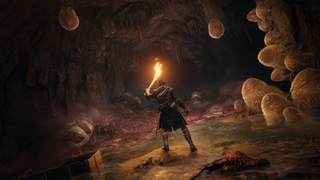Elden Ring is a great example of an open world working smarter, game devs say
Game devs say Elden Ring's open world works smarter, not harder

Elden Ring has one of the biggest and densest game worlds in recent memory, and many game developers reckon it's also one of the most efficiently designed.
FromSoftware's effective reuse of enemies, buildings, props, and other assets throughout Elden Ring's Lands Between has sparked discussion among devs across the industry. Katie Chironis, lead world designer at Riot Games, noted how "a few changes in key props and art" can create "many different-feeling areas."
"Many points of interest are similar or identical but are dressed a little differently; you’d never notice Roderika’s initial shack shares its pieces with the artist’s shack and the first shack you find in Caelid," Chironis said on Twitter.
Chironis and several other devs speculated that Elden Ring leverages tool-generated buildings as a base, perhaps using the aptly named tool Houdini and then retouching the results to give them some added vim. FromSoftware's exact development process is unknown, but there's little doubt that the studio got it down to a science in the process of detailing Elden Ring's irresponsibly large world.
"They do a lot with fog, weather, lighting, and color grading to set each area apart too," added Tom Farnsworth, senior design lead at Bungie. "Shows how important it is to know what’s actually distinct to a player's perceptions vs adding needless variety and detail. Third-person makes this much simpler too."

Bruno Dias of Failbetter Games argues Elden Ring is "one of the greatest asset reuse case studios" out there, and likewise praised how effectively FromSoftware distinguishes reused entities. The familiar churches, for example, are "integrated into their environment – they have the local plants growing on them, or they're fucked up and blasted in the specific way the local area has been fucked up and blasted," as Dias put it. Speaking with GamesRadar, Dias stressed that he doesn't work super closely with this kind of asset pipeline and was simply making general observations, but his points speak to FromSoftware's overall approach and were echoed by many other developers.
Others noted that Elden Ring not only gets the most out of its own assets, it also repurposes art from previous FromSoftware games, with several enemies, bosses, animations, and more making an appearance in the Lands Between in some shape or form without looking out of place. Asset reuse is too often treated as a dirty word or mislabeled as a copout, when in reality, as Elden Ring and many other games demonstrate, it's a common and valuable technique which can enable more ambitious games and trim development times. Imagine how much smaller the Lands Between would be, or how much longer it would've taken to create, if absolutely everything had been built from scratch.
Sign up to the GamesRadar+ Newsletter
Weekly digests, tales from the communities you love, and more
Elden Ring came out a lot bigger and more complex than originally planned, according to director Hidetaka Miyazaki.
Austin freelanced for the likes of PC Gamer, Eurogamer, IGN, Sports Illustrated, and more while finishing his journalism degree, and he's been with GamesRadar+ since 2019. They've yet to realize that his position as a senior writer is just a cover up for his career-spanning Destiny column, and he's kept the ruse going with a focus on news and the occasional feature, all while playing as many roguelikes as possible.

Stellar Blade director "grew up too poor to afford" a PS1, but when he finally got one in college, Ridge Racer and Final Fantasy inspired him to make games

Oh, that's why the Stellar Blade devs were terrified by demo players: one fan's spent "about 60 hours" maxing Eve's skill tree before the action RPG is even out
Most Popular







